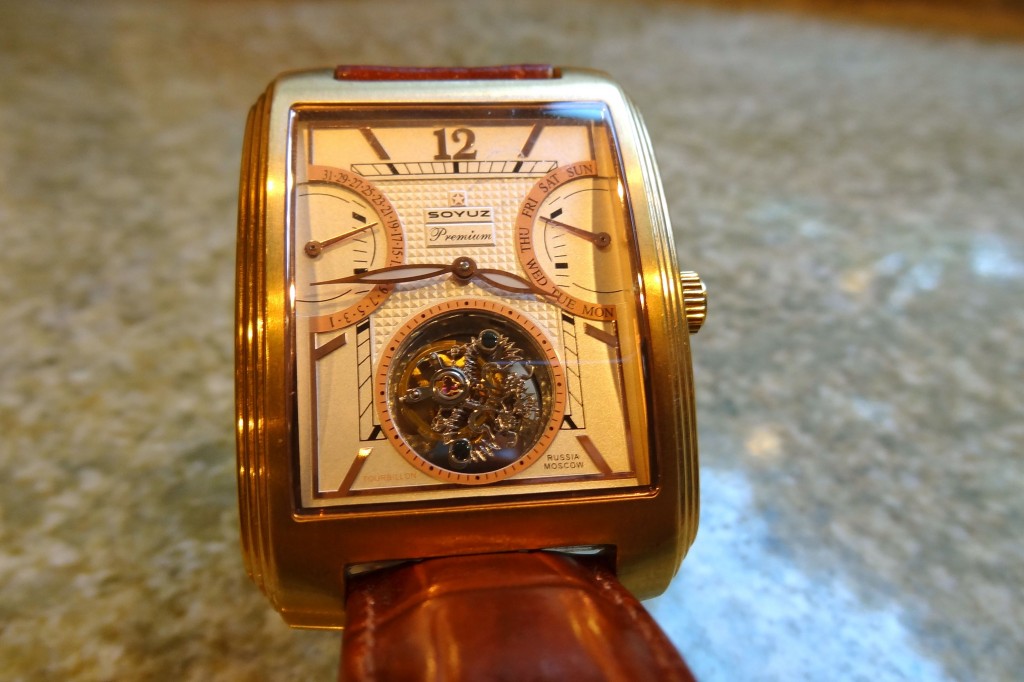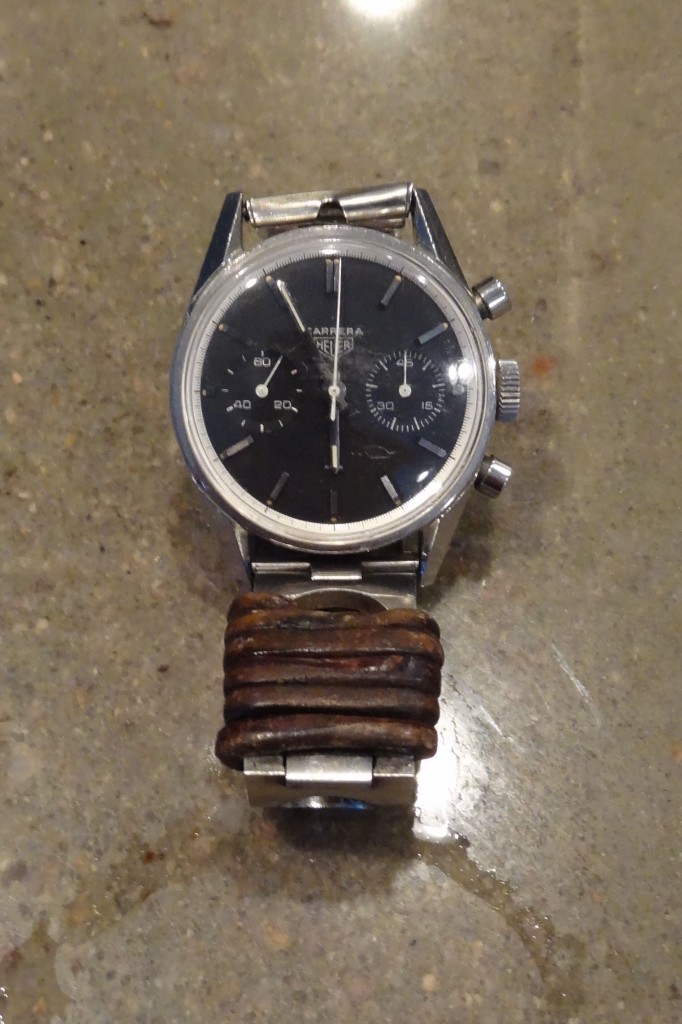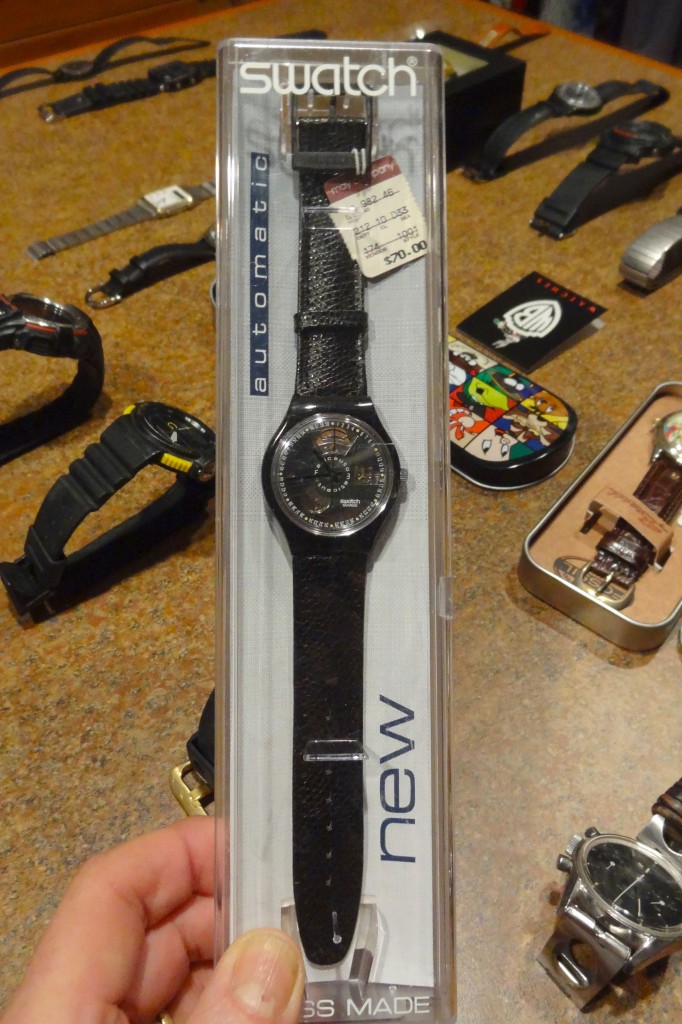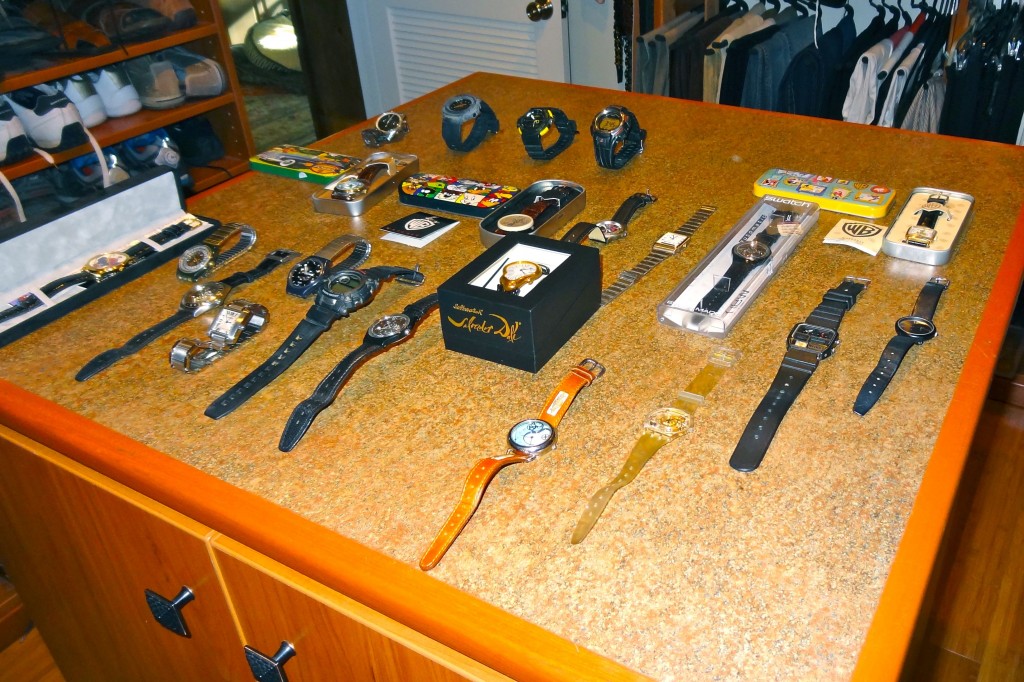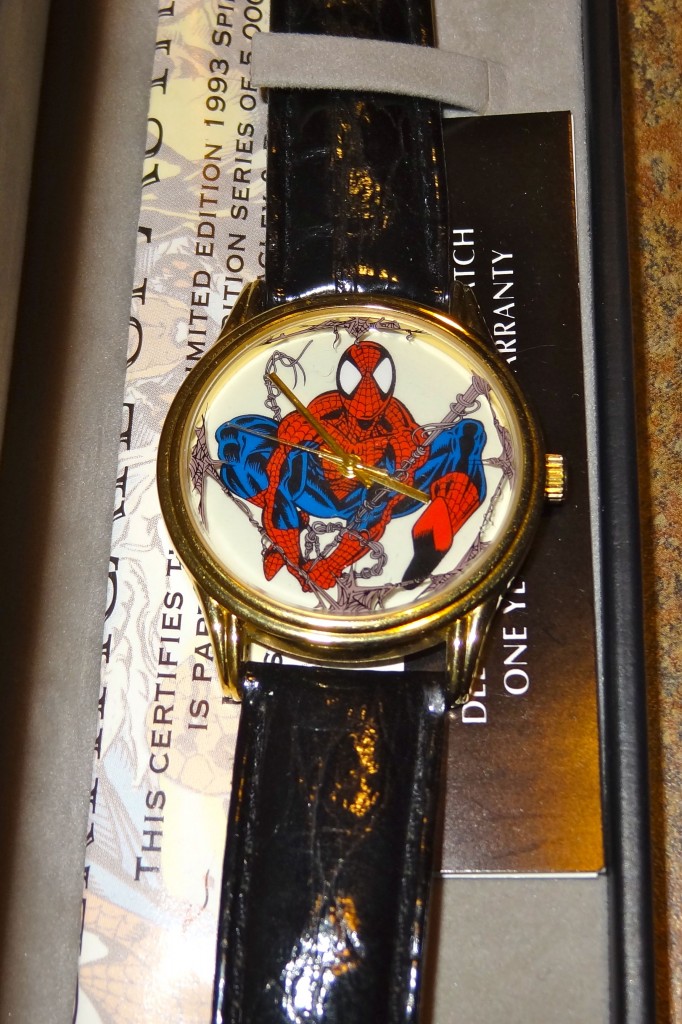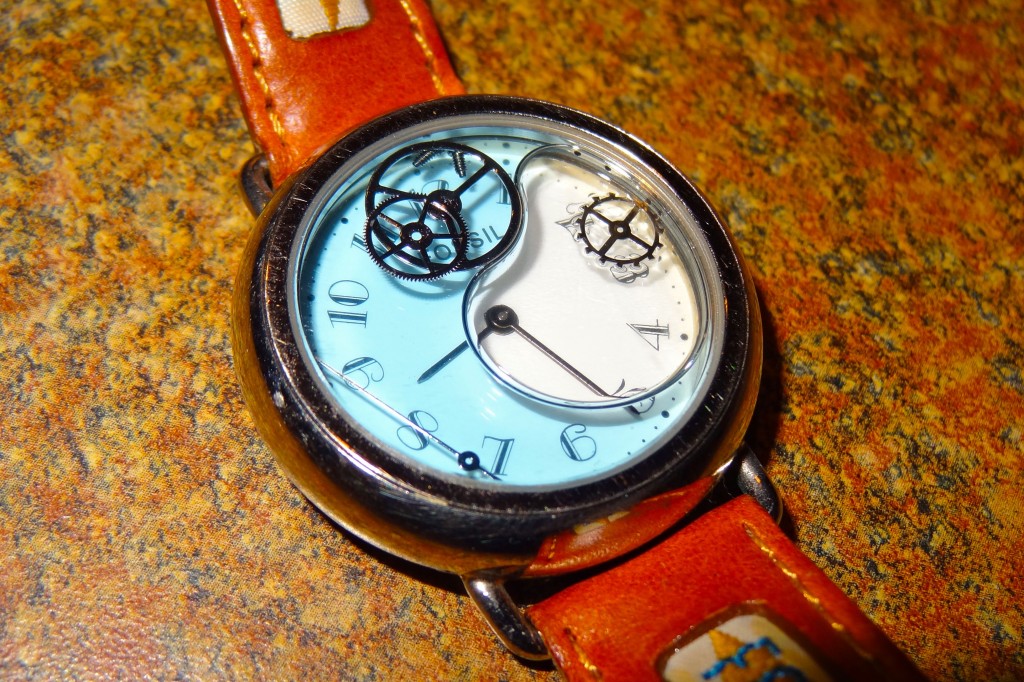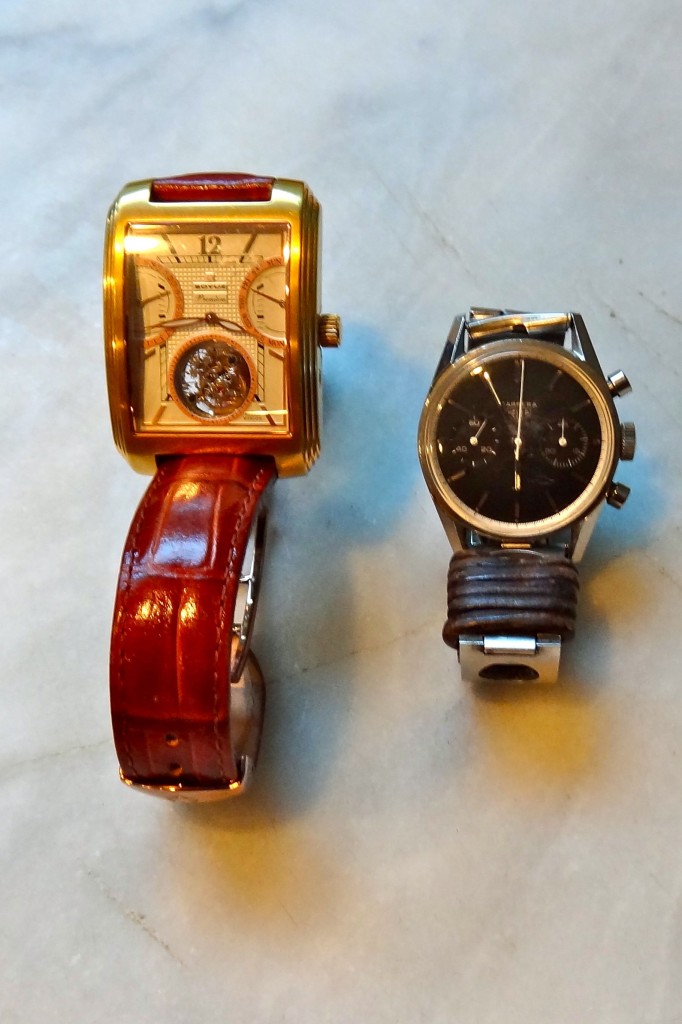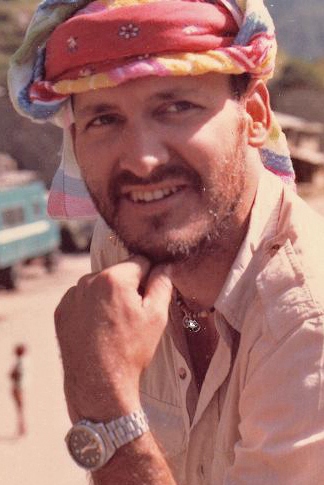The Evolution of Technology blog series is written by Bruce Sallan and Professor David E. Weber
Our series continues with one of my favorite old tech devices: the watch. Yeah, a watch: analog and perhaps one you had to wind (do kids know what that means?). I had a love affair with watches when I was a kid so this will be a fun column to write!
Since Professor Weber and I alternate first starting each column, it’s my turn to start off!
I wonder if kids are even taught to read an analog clock/watch or is it all digital for them? I remember learning how to “tell time.” There were games and books that helped kids learn to read a clock. Obviously, it’s not very hard, but it was still a skill a child would learn.
I had a love of watches that came from where, I don’t know. I remember my family did two big vacations in my youth, one of which was to the Caribbean and when we stopped in St. Thomas, it was a veritable bonanza of watch-stores. I was in heaven. I particularly remember loving a watch that had a moiré-type of pattern in it and I thought it was beyond cool.
But, the first watch I owned was purchased shortly after my Bar Mitzvah. This story illustrates such a dichotomy of values from my youth to my own parenting and my own kids. My parents insisted that I save the majority of money I was given for my Bar Mitzvah. Most gifts were in the form of money and I got probably around $1,000 or so from the guests. My parents gave me a $75 watch allowance.
I had already staked out the watch I wanted at a local watch store, The Feldmar Watch Company on Pico Blvd, in a neighborhood called Beverlywood. I would go to Feldmar regularly, prior to my Bar Mitzvah, and look at the Heuer watch I had chosen. This was before, I suppose, they became Tag-Heuer. The watch was a simple chronograph with a stopwatch that showed seconds, minutes, and hours.
It was gorgeous to me and cost just $75. What I really wanted, however, was the same model that had this cool new feature: the date in a small box on the watch face. But, alas, it was beyond my budget and I purchased the date-less model. That was “my watch” for many, many years.
Somewhere along the line, during my college years, I wrapped a piece of leather around the metal strap. It meant something to me that I’ve since forgotten, but I think it had to do with my first serious broken heart.
Later on, after this watch pretty much stopped keeping time – it required winding since this was prior to any battery operated watch. There were the so-called “automatic” watches that would run on movement generated by wearing them. After putting my beloved Heuer to rest, I began buying inexpensive watches made by such companies as Casio, Swatch, and Fossil. My only criterion was that it cost less than $100. I took peculiar pride in finding good-looking cool watches that were inexpensive.
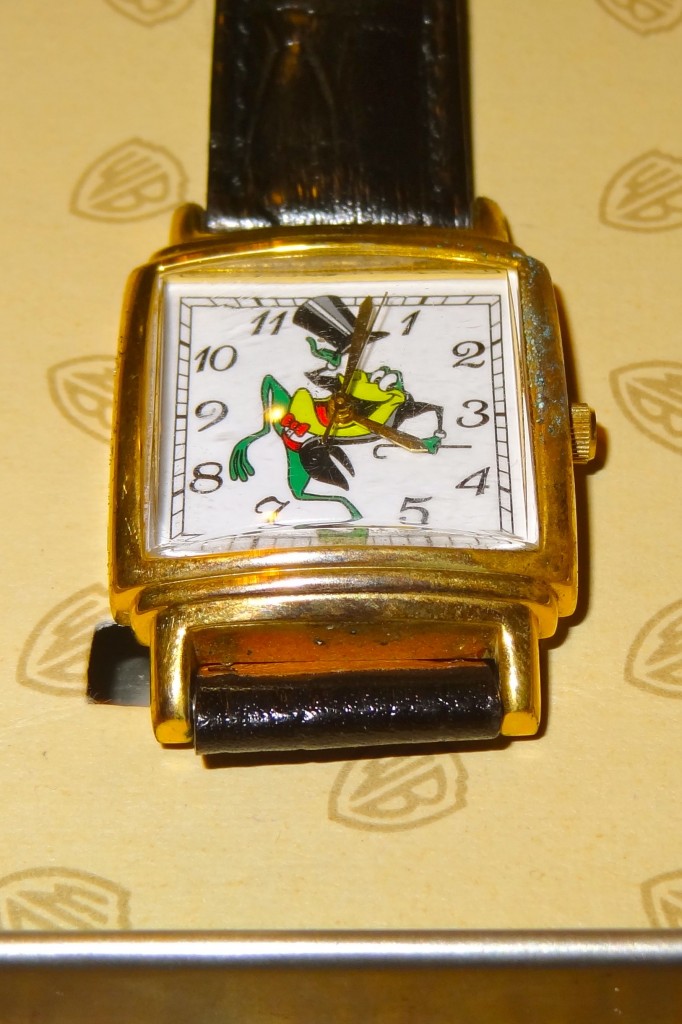
I LOVED Michigan J. Frog from the classic Chuck Jones cartoon, "One Froggy Evening," long before the WB adopted him as their original mascot
One particular watch I bought was in the middle of my show-biz career. I worked for Daniel Melnick, a well-known film producer, running his television division. It was prior to my first marriage and I was in my thirties. My favorite watch at the time was a basic Fossil that had those batteries that kept it going and its uniqueness was that it had colored water in the watch in which there were floating watch parts.
Daniel Melnick was a very classy guy. Seriously. He had impeccable taste in everything and was the very definition of both raconteur and Renaissance man. He had an incredible modern art collection that was housed in an architectural modern home just above Sunset Blvd.
He was a friend of anyone and everyone in Hollywood. In fact, it was his poker game, when he lived in New York, that was the backdrop basis for the poker game that Neil Simon depicted in his play, “The Odd Couple.” Neil Simon was one of the players.
One of his good friends was Steve Martin, the comedian. Both were art collectors and connoisseurs of fine things. I had suggested that we try to get Steve Martin to work with us on a comedy television series and a meeting was arranged.
Now, to fully set up this scenario, Dan Melnick also had a serious watch collection. It was one of those watch collections in which he had winders in which he stored his watches, none of which cost less than $10,000 and many cost many multiples of that. He would rotate wearing a prized watch each day.
The meeting was set. Steve Martin arrived. I’m wearing my current favorite Fossil with the floating parts in it, and I’m invited by Dan’s assistant to join the meeting. We sit in the couch area and I’m introduced to Steve Martin. The first thing he notices is my watch, commenting something to the effect, “Wow, that is a great looking watch.”
Dan is sitting nearby, wearing one of his extravagant thousands-of-dollar collectible watches and I could see steam come out of his ears. It was a priceless moment, to say the least.
All my life, I loved good watches. However, I never felt the need or was comfortable spending what they cost. I inherited a beautiful gold watch from my dad, but it was only valuable due to its gold band.
One day, my wife and I went to her favorite jewelry store where we had gotten her wedding ring. I’d always fantasized about getting a Tourbillon watch. A Tourbillon watch simply means it has a “movement” that is called “Tourbillon” and it is considered the most precise movement of any classic winding watch. All the big brand jewelers make and sell Tourbillon watches that often cost in excess of $100,000 and even can carry a price tag of $1,000,000 and up. They are usually produced in a under-100 limited number.
I had heard, and even done a little Internet research, that China had started making decent Tourbillon watches that cost in the single-digit thousands. I asked Alan, the owner, what he thought or knew about them. He said that most of the Chinese versions were lousy, but that Russia was now making less expensive Tourbillon watches, at which point he shows us the “only” one he had, in his display case.
He normally doesn’t carry expensive watches, preferring to devote his business to expensive jewelry and his work is quite beautiful. But, he’d seen this watch at a jewelry convention and bought one just for the fun of it. I was in love. I wanted it soooo bad, but the price tag – very reasonable – still felt out of my comfort zone.
Later that year, my wife got me that watch for my birthday. It’s pictured below, next to my first watch.
Well, rather than a specific “Evolution of Technology” column, my contribution has really been simply a walk down my memory lane regarding watches. Yes, we all know the technology of watches is significantly improved, but it’s also sad and odd that many younger people rely simply on their cell-phones for the time. Will watches become just a niche thing for those that live in the past and/or like to collect things? I suppose time will tell.
Now, I turn it over to Professor Weber.
I’ll offer a few thoughts on the evolution of technology theme…but first; I do have a couple of reminiscences to share.
The first is that when Bruce and I were college students, he intentionally never wore a watch. During that period, his opinion was that attending to time was supremely conformist; to wear a watch, then, simply bought into a bleak, sterile vision for humanity. A few years later, when Bruce was moving up the ladder in show business, he wore a watch because he quickly appreciated that keeping close track of time was imperative in an industry that always operated in fourth gear (Note from Bruce: I don’t remember this, but it sounds SO like me and I know David remember things so very well!).
I taught elementary school for a few years in the late 1970’s. One day, at recess, another teacher’s pupil approached me to ask what time it was. I pointed to a large outdoor clock, visible from the playground and mounted above the administration building entrance. He contemplated the thick hands sweeping in a circle formed by the twelve numbers and said, “I can’t tell that kind of time.” So even then, the first wave of digital timepieces had begun to erode children’s ability to read traditional clock faces.
Today, if I refer to a specific time of day with my twenty-something college students, I have learned to say, for example, “It’s forty minutes past ten” instead of the more logical (to me, anyway, because I learned to frame time with as small a number of minutes as possible), “…twenty to eleven.” Some of the students don’t understand terms such as “half-past” the hour or “three-quarters of an hour.” Surely that is because they did not play the fraction or “pie slice” games (i.e., clock face equals pie, half a pie means half an hour, and so on) that Bruce and I did when we learned how to tell time.
Which reminds me: When I was in grammar school, if someone asked you what time it was, you would typically reply, “Half-past a monkey’s ***, a quarter past his *****” (Its G-rated version was to reply by glancing at your wrist and declaring it was “two hairs past a freckle”). I am guessing that those of you born since 1980 would be unfamiliar with that doggerel!
I remember a high school history teacher telling us that the clock was one of the two or three most important of humankind’s inventions. Leaps forward in creating devices to measure time in units other than natural ones (e.g., minutes and seconds instead of sunrise and sunset) occurred in China, North Africa, and Europe over the millennia.
One reason I enjoy backcountry wilderness travel is that after a couple of days, your body embraces a natural timing marked out solely by daylight and darkness. The concepts “9.43 a.m.” or “high noon” become irrelevant—after a week or more, virtually forgotten. You wake up more or less when the sun rises, attempt to get somewhere you’ll want to stay for the night before it gets too dark, and stop for food or rest when necessary throughout the day. A little ritual I enjoy is to stop for a moment at the trailhead to bury my watch in my backpack for the duration of the trek (Note from Bruce: What is “wilderness”? What is “backcountry”?).
Compare the rhythm of nature’s time to the artificially constrained time of my class meetings. I usually have exactly fifty minutes for class. I plan the events tightly: four minutes for welcome and announcements; sixteen minutes for a lecture; eight minutes to screen a two-minute video clip illustrating a key topic from the lecture and then I facilitate a brief class discussion of how the lecture material applies to the clip; eight minutes to introduce and run a team task designed to develop skills related to the specific lecture material; four minutes to debrief that activity; five minutes to introduce and answer questions about the writing assignment due in one week; plus a five-minute “time bank” in case I need an extra minute here or there (No student has ever complained if I dismiss class a few minutes early because I didn’t need to “withdraw minutes” from the “time bank”!). In your own careers, I expect you do the equivalent, and probably then some (Note from Bruce: Professor, I think you’ve eclipsed your own record with the longest sentence in our blog series, in this paragraph!).
Not too many years ago, if I happened to leave home without a wristwatch, I could walk among my students and catch sight of the time on the analog wristwatch at least one of them would be wearing (The time on someone else’s digital watch is difficult to see at an angle). But each year, fewer of my students wear wristwatches of any kind. They tell time with their mobile phones, laptops or tablets, which are not readily visible to me. To signal, unintentionally or not, that we have only a couple of minutes before class must end, the students perform what communication specialists call “exiting cues” (e.g., gathering up papers, slipping into jackets). But the first time I observe such behavior, I discourage it, to enable the students to practice using common courtesy. “Don’t worry,” I assure them, “I will always let you out on time, or perhaps even early. Lose the exiting cues!”
Another change in keeping time is the difficulty of finding out the correct time to set a timepiece by. In the mid-1960s, in L.A., one simply contacted the “Time Lady” (well, that was my name for her). You would call a certain easy-to-remember telephone number (something like 555-4242), and immediately hear a recorded female voice, very authoritative, announce, “At the tone, the time will be ___.” This sometimes hypnotized me; I might listen to the time announcements cycle through for a few minutes.
To get the exact time today, the Internet is the way to go, unless you have an app on your phone hooking you into some atomic clock somewhere. Not having such an app, I visit the webpage for the U. S. Naval Observatory Master Clock. I don’t even know what phone number I’d call for the exact time. In the late ‘90s (I lived in Denver then), when I last would use the phone to ascertain the time of day, a couple of brief recorded advertisements wasted a minute or so of your life before you could hear an actual time announcement.
Something I share with Bruce is a love of wristwatches. I own about ten. In price they average in the mid-hundreds of dollars—nothing fancy, although I can tell you several brands I would buy if I won the lottery. I too received a watch for my bar mitzvah, a Bucherer, a low-end but still good-quality Swiss watch with a beautiful mid-century modern design. I once took it to a watch smith in Denver for repairs and he misplaced it…or stole it! I had a vintage Gruen watch with its original metal stretch band, a timepiece my dad purchased in the late 1940s. It disappeared somewhere in New York City in 2002…I suspect a subway pickpocket slipped it off my wrist.
I still have a Seiko watch that I purchased in Singapore in 1982, when I lived in Indonesia. Almost all of my fellow expats wore Rolex stainless steel watches they had purchased in Hong Kong or Singapore. But they earned more money than I did. The best I could do was to acquire Seiko’s timepiece designed to mimic their Rolexes.
My first watch, though, was a cheap silver Timex. My dad bought for me at a Sav-On drugstore one Saturday when I was nine or ten. Some of my friends had started wearing watches and I figured I should as well. Dad and I changed out the leather band for a metal Twist-O-Flex stretch band. I spent hours monkeying with that band! I was as proud of my Timex and its after-market Twist-O-Flex as my expat friends were of their Rolex Submariners!
Get my new book – just click on the cover image below:

